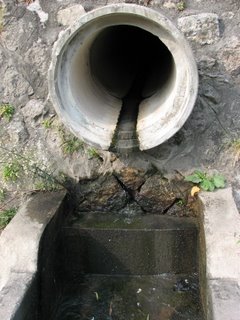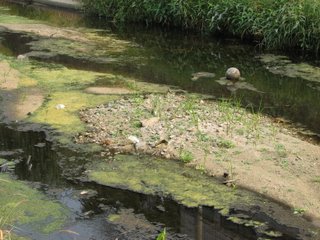 My usual Sunday morning walking companion didn't make it today because he was hungover (tsk, tsk), so I thought I would make a side trip that I had been considering for quite some time. I really enjoy walking along Cheonggyecheon, and I had noticed that there are two "tributaries". I have been quite curious because I assumed that the tributaries would be like mini-Cheonggyecheons and that more of Cheonggeycheon had to be even better.
My usual Sunday morning walking companion didn't make it today because he was hungover (tsk, tsk), so I thought I would make a side trip that I had been considering for quite some time. I really enjoy walking along Cheonggyecheon, and I had noticed that there are two "tributaries". I have been quite curious because I assumed that the tributaries would be like mini-Cheonggyecheons and that more of Cheonggeycheon had to be even better.Well, my curiosity has been satisfied, and, as they say, curiousity kills the cat (it almost did). The first little
 stream that joins the Cheonggyecheon about halfway down the main stream was my target. Five minutes of walking along that foul little stream was enough to make me gag.
stream that joins the Cheonggyecheon about halfway down the main stream was my target. Five minutes of walking along that foul little stream was enough to make me gag.Now I can understand that they may not have had enough money to fix up all the little streams as they flow through an industrial recycling area where they were dismantling all manner of household appliance. However, to let this foul water join the Cheonggyecheon beggars belief. What is the point of starting out with clean water and then adding sewage and industrial waste to it? It certainly explains why the Cheonggyecheon stinks so much at the southern end just before it empties into a larger river. Why not put this water into a proper sewer system?
I read recently (Stream Improving Seoul's Air Quality) that there were now 23 varieties of fish in the Cheonggyecheon. I hope that they are upstream from this.
 That soccer ball is probably left over from the 2002 World Cup.
That soccer ball is probably left over from the 2002 World Cup.


3 comments:
You Vancouverans (Vancouverites? Vancouverese?) have far too ideal expectations for cleanliness.
Maybe this would get more attention if one of those sewage pipes oozing filth into the stream were coming from a US military base or the home of a womanizing foreign English teacher.
This is so sad. I'm glad that you posted about it though. Maybe if bloggers did a bettter job of documenting things like this then there would be more pressure to change.
Unfortunately, my readership probably doesn't include my people in decision makeing part of the Korean government. :-)
Post a Comment